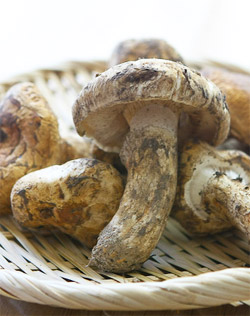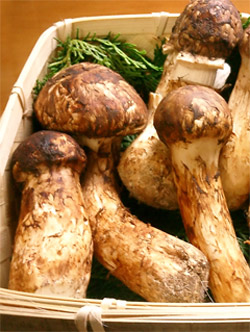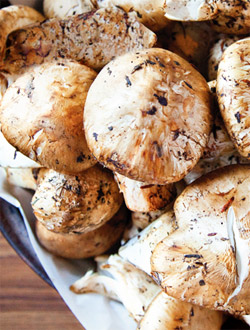|
|
Matsutake Mushrooms: The Costliest Food in the World

Matsutake is the common name for a highly sought-after mycorrhizal mushroom
that grows in Asia, Europe, and North America. It is prized by the Japanese and
Chinese for its distinct spicy-aromatic odor.
Matsutake grow under trees and are usually concealed under fallen leaves and
duff on the forest floor. It forms a symbiotic relationship with the roots of a
limited number of tree species. Matsutake are known to grow in China, Japan,
Korea, Laos, Canada, Finland, the United States, Sweden, among other countries.
In Japan it is most commonly associated with Japanese Red Pine.
In the North American Pacific Northwest Tricholoma magnivelare is found in
coniferous forests made up of one or more of the following species: Douglas-fir,
Noble Fir, Shasta Red Fir, Sugar Pine, Ponderosa Pine, or Lodgepole Pine. In
California and parts of Oregon, it is also associated with hardwoods, including
Tanoak, Madrone, Rhododendron, Salal, and Manzanita. In northeastern North
America, the mushroom is generally found in Jack Pine forests. T. magnivelare is
typically called White Matsutake as it does not feature the brown coloration of
the Asian specimen.
In 1999, N. Bergius and E. Danell reported that Swedish (Tricholoma nauseosum)
and Japanese matsutake (T. matsutake) are the same species. The report led to
increased import of matsutake from Northern Europe to Japan because of the
comparable flavor and taste.
Though simple to harvest, Matsutake are hard to find, causing the price to be
very high. Domestic production of matsutake in Japan has been sharply reduced
over the last 50 years due to a pine nematode Bursaphelenchus xylophilus, and it
has influenced the price a great deal. The annual harvest of matsutake in Japan
is now less than 1,000 tons, and the Japanese mushroom supply is largely made up
by imports from China, Korea, the North American Pacific Northwest (Northern
California, Oregon, Washington, and British Columbia), and Northern Europe
(Sweden and Finland).
The price for matsutake in the Japanese market is highly dependent on quality,
availability, and origin. The Japanese matsutake at the beginning of the season,
which is the highest grade, can go up to $2,000 per kilogram. In contrast, the
average value for imported matsutake is about $90 per kilogram.
They are sometimes called "pine mushrooms" due to their association with certain
types of pine trees. Pine mushrooms begin their lives looking pure white and
smooth, they soon develop brown spots and scales. Their caps are usually around
2 to 8 inches across (5 to 20 cm) and convex. When the mushroom is young, the
caps have a distinct curl to their edges. Stems are 2 to 6 inches (4 to 15 cm)
tall and are firm throughout, never hollow. The stems often have an interesting
two-toned look, with the area below the ring displaying their brownish
discolorations, and the area above being pure white.
These mushrooms have a ring around the stem, which is a remnant of their partial
veil. The partial veil is a layer of tissue that runs from the outer edge of the
cap and connects to the stem. Its function is to protect the developing gills
when the mushroom is young. Their spore print is white. Matsutake are most
commonly found in North America in California and the Pacific Northwest.
However, they are known to grow in other places such as Japan, Korea, China, and
the Northern European countries of Sweden and Finland.
 Pine mushrooms are mycorrhizal partners with various species of trees (more on
this below). They are mainly found under pine and fir trees, but sometimes under
hardwoods such as oaks or tanoaks. Pine mushrooms are mycorrhizal partners with various species of trees (more on
this below). They are mainly found under pine and fir trees, but sometimes under
hardwoods such as oaks or tanoaks.
They start popping up in late summer and fall (Sep-Oct) in cooler climates and
winter (through Jan) in warmer climates. As with so many mushrooms, the Latin
naming convention isn't always so cut and dry. Asian and Northern European
species are referred to as Tricholoma matsutake, while North American mushrooms
are often called Tricholoma magnivelare. At this point it is unclear whether
these are actually the same species.
Matsutake are held in high regard the world over for their powerful flavor and
odor. They're a sensory adventure often referred to as "spicy", "intense", or
"like cinnamon".
Although some would prefer the terms "foul" or "pungent"! These words do little
justice to the true spicy intensity of the mushroom, which is better experienced
than described.
Health Benefits of Matsutake Mushrooms
Modern medicine found these mushrooms to be excellent sources of proteins,
vitamins and minerals. They are full of vitamins A, B6, C and also thiamine,
niacin and riboflavin and also contain plenty of minerals such as: potassium,
sodium, iron, copper, calcium and phosphorus. Copper is important for many
different biochemical reactions in the body and also for the production of red
blood cells, which makes these mushrooms valuable. Potassium found in high
amounts in matsutake mushrooms is responsible for the healthy heart and muscles
and provide the fluid balance in the body.
These mushrooms are completely without cholesterol and contain just traces of
fat, and because of that they are considered to be very healthy.
Matsutake mushrooms are proven to be effective fighting different cancers. Many
medications are used to treat cancerous changes in the body but all of them
affect the healthy tissue to some extent, causing serious side effects. If these
anti-cancer medications kill cancer cells they will most certainly kill some of
the healthy cells in the body, because the drugs can�t differentiate between
healthy and cancer cells. Matsutake mushrooms are believed to be a natural
anti-cancer remedy, that doesn't have unwanted side effects.
Most cancers are considered to be the result of the pollution damage of our
cells. Carcinogens from the industry, such as benzene are blamed for almost 80%
of all cancer cases. Matsutake mushrooms have anti-cancerous properties, due to
the substances present in them. These substances are: different glycans,
polysaccharides AB-P and AB-FP, at least different steroids, uronyde, and some
nucleic acid elements are responsible for carcinostatic properties of these
mushrooms.
 Matsutake mushrooms were proven helpful in over 85% in the some animal testing
for carcinomas. They showed positive results on animals tested also for: solid
cancers and cancers induced by chemicals. These mushrooms can prevent the
metastasis of carcinoma cells, because they can affect and reinforce the immune
system. They are also found to prevent the risk of cancers by regular
consummation. Matsutake mushrooms were proven helpful in over 85% in the some animal testing
for carcinomas. They showed positive results on animals tested also for: solid
cancers and cancers induced by chemicals. These mushrooms can prevent the
metastasis of carcinoma cells, because they can affect and reinforce the immune
system. They are also found to prevent the risk of cancers by regular
consummation.
A new study, conducted by a government research institution in France, indicates
that the white button mushroom (Agaricus bisporus) has at least as much
antioxidant power as more expensive varieties like maitake and matsutake.
White button mushrooms are the youngest form of Agaricus bisporus. If left to
grow, white button mushrooms turn into Crimini mushrooms. When Crimini mushrooms
are left to grow another 2-3 days, they turn into Portobello mushrooms.
White button, Crimini, and Portobello mushrooms are naturally rich in the entire
spectrum of B vitamins, except vitamin B-12. They are also rich in a number of
minerals, including selenium, copper, potassium, and phosphorus.
The many naturally occurring antioxidants found in white button, Crimini, and
Portobello mushrooms make them excellent food choices for promoting optimal
immune system strength and preventing age-related degeneration, particularly
neural degeneration related to cognitive decline.
Video
Dated 18 March 2014
|
|
|
|
|









